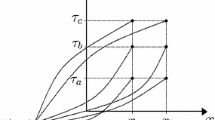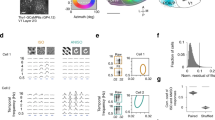Abstract
Convergence between cells which differ in both spatial and temporal properties create higher order neurons with response properties that are distinctly different from those of the input neurons. The spatial properties of target neurons are not necessarily “cosinetuned”. In addition, unlike the independence between spatial and temporal properties in cosine-tuned afferent neurons, higher-order target cells generally exhibit a dependence of temporal dynamics on spatial properties. The response properties of target neurons receiving spatio-temporal convergence (STC) from tonic and phasic-tonic or phasic afferents is investigated here by considering a general case where the dynamic input is represented by a fractional, leaky, derivative transfer function. It is shown that, at frequencies below the corner frequency of the dynamic input, the temporal properties of target neurons can be described by leaky differentiators having time constants that are a function of spatial direction. Thus, STC target neurons exhibit tonic temporal response properties during stimulation along some spatial directions (having small time constants) and phasic properties along other directions (having large time constants). Specifically, target neurons encode the complete derivative of the stimulus along certain spatial directions. Thus, STC acts as a directionally specific high-pass filter and produces complete derivatives from fractional, leaky derivative afferent signals. In addition, spatio-temporal transformations can generate novel temporal dynamics in the central nervous system. These observations suggest that spatio-temporal computations might constitute an alternative to parallel, independent spatial and temporal channels.
Similar content being viewed by others
References
Abramowitz EA, Stegun EA (eds) (1970) Handbook of mathematical functions. Dover, New York
Angelaki DE (1991) Dynamic polarization vector of spatially tuned neurons. IEEE Trans Biomed Eng 38(1):1053–1060
Angelaki DE (1992a) Spatio-temporal convergence (STC) in otolith neurons. Biol Cybern 67:83–96
Angelaki DE (1992b) Vestibular neurons encoding two-dimensional linear acceleration assist in the estimation of rotational velocity during off-vertical axis rotation. Ann N Y Acad Sci 656:910–913
Angelaki DE (1993) Generation of two-dimensional spatial and temporal properties through spatio-temporal convergence of one-dimensional neurons. IEEE Trans Biomed Eng in press
Angelaki DE, Bush GA, Perachio AA (1992) A model for the characterization of the spatial properties in vestibular neurons. Biol Cybern 66:231–240
Angelaki DE, Bush GA, Perachio AA (1993) Two-dimensional spatio-temporal coding of linear acceleration in vestibular nuclei neurons. Neuroscience 13:1403–1417
Bush GA, Perachio AA, Angelaki DE (1993) Encoding of head acceleration in vestibular nuclei neurons I. Spatio-temporal response properties to linear acceleration. J Neurophys (in press)
Chen WJ, Poppele RE (1978) Small-signal analysis of response of mammalian muscle spindles with fusimotor stimulation and a comparison with large-signal responses. J Neurophysiol 41:15–27
Fernandez C, Goldberg JM (1971) Physiology of peripheral neurons innervating semicircular canals of the squirrel monkey. II. Response to sinusoidal stimulation and dynamics of peripheral vestibular system. J Neurophysiol 34:661–675
Fernandez C, Goldberg JM (1976a) Physiology of peripheral neurons innervating otolith organs of the squirrel monkey. I. Response to static tilts and to long duration centrifugal force. J Neurophysiol 39:970–984
Fernandez C, Goldberg JM (1976b) Physiology of peripheral neurons innervating otolith organs of the squirrel monkey. III. Response dynamics. J Neurophysiol 39:996–1008
Fernandez C, Goldberg JM, Abend WK (1972) Response to static tilts of peripheral neurons innervating otolith organs of the squirrel monkey. J Neurophysiol 35:978–997
Goldberg JM, Desmadryl G, Baird RA, Fernandez C (1990) The vestibular nerve of the chinchilla. IV. Discharge properties of utricular afferents. J Neurophysiol 63:781–790
Hain TC (1986) A model of the nystagmus induced by off vertical axis rotation. Biol Cybern 54:337–350
Hess BJM (1992) Three-dimensional head angular velocity detection from otolith afferent signals Biol Cybern 67:323–333
Hess BJM, Angelaki DE (1993) Modelling spatiotemporal properties of directionally sensitive multi-input single-output systems. Biol Cybern (in press)
Loe PR, Tomko DL, Werner G (1973) The neural signal of angular head position in primary afferent vetibular nerve axons. J Physiol (Lond) 219:29–50
Matthews PBC (1984) Muscle spindles: their messages and their fusimotor supply. In: Brooks VB (ed) Motor control, pt 1. (Handbook of physiology, sect 1, The nervous system, Vol II) American Physiological Society, Bethesda, Md, pp 189–228
Melvill Jones G, Milsum JH (1969) Neural response of the vestibular system to translational acceleration. In: Supplement to Conference on Systems Analysis Approach to Neurophysiological Problems, Brainerd, Minn, pp 8–20.
Niven JI, Hixson WC Correia MJ (1966) Elicitation of horizontal nystagmus by periodic linear acceleration. Acta Otolaryngol (Stockh) 62:429–441
Ogata K (1970) Modern control engineering. Prentice-Hall, Englewood Cliffs NJ
Perachio AA (1981) Responses of neurons in the vestibular nuclei of awake squirrel monkeys during linear acceleration. In: Gualtierotti T (ed) The vestibular system: function and morphology, Springer, New York Berlin Heidelberg, pp 443–451
Schor RH, Miller AD, Timerick JB, Tonko DL (1985) Responses to head tilt in cat central vestibular neurons. II. Frequency dependence of neural response vectors. J Neurophysiol 53:1444–1452
Xerri C, Barthelemy F, Harlay L, Borel L, Lacour M (1987) Neuronal coding of linear motion in the vestibular nuclei of the alert cat. I. Response characteristics to vertical otolith stimulation. Exp Brain Res 65:569–581
Wilson VJ, Melvill Jones G (1979) Mammalian vestibular physiology. Plenum Press, New York
Author information
Authors and Affiliations
Rights and permissions
About this article
Cite this article
Angelaki, D.E. Spatial and temporal coding in single neurons. Biol. Cybern. 69, 147–154 (1993). https://doi.org/10.1007/BF00226198
Received:
Accepted:
Issue Date:
DOI: https://doi.org/10.1007/BF00226198




